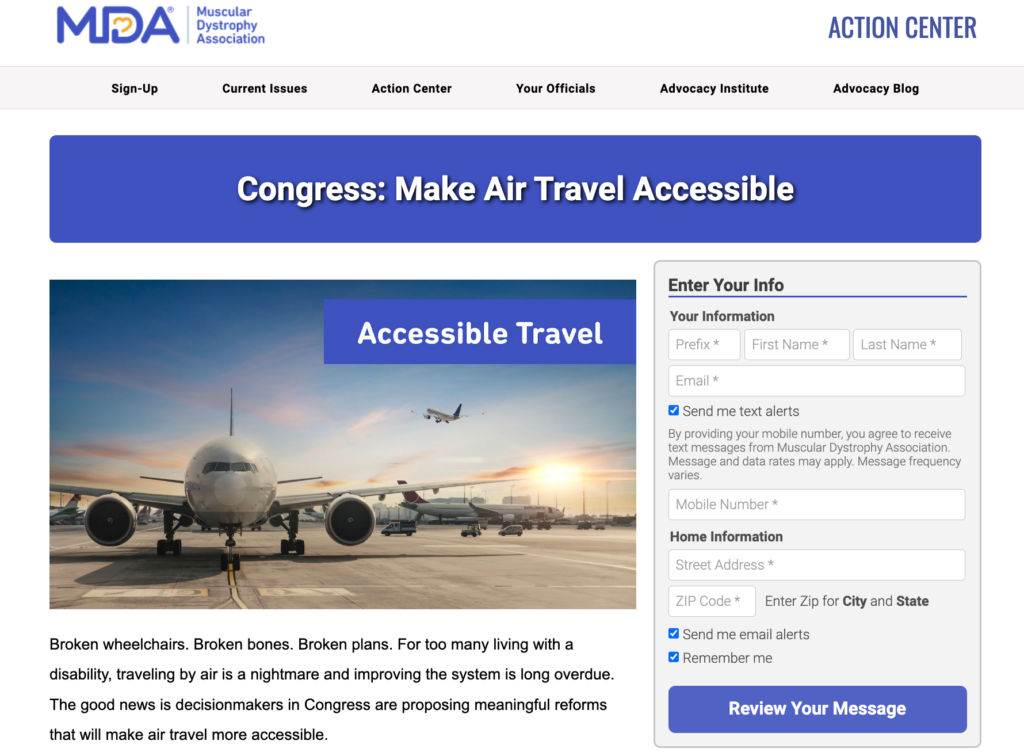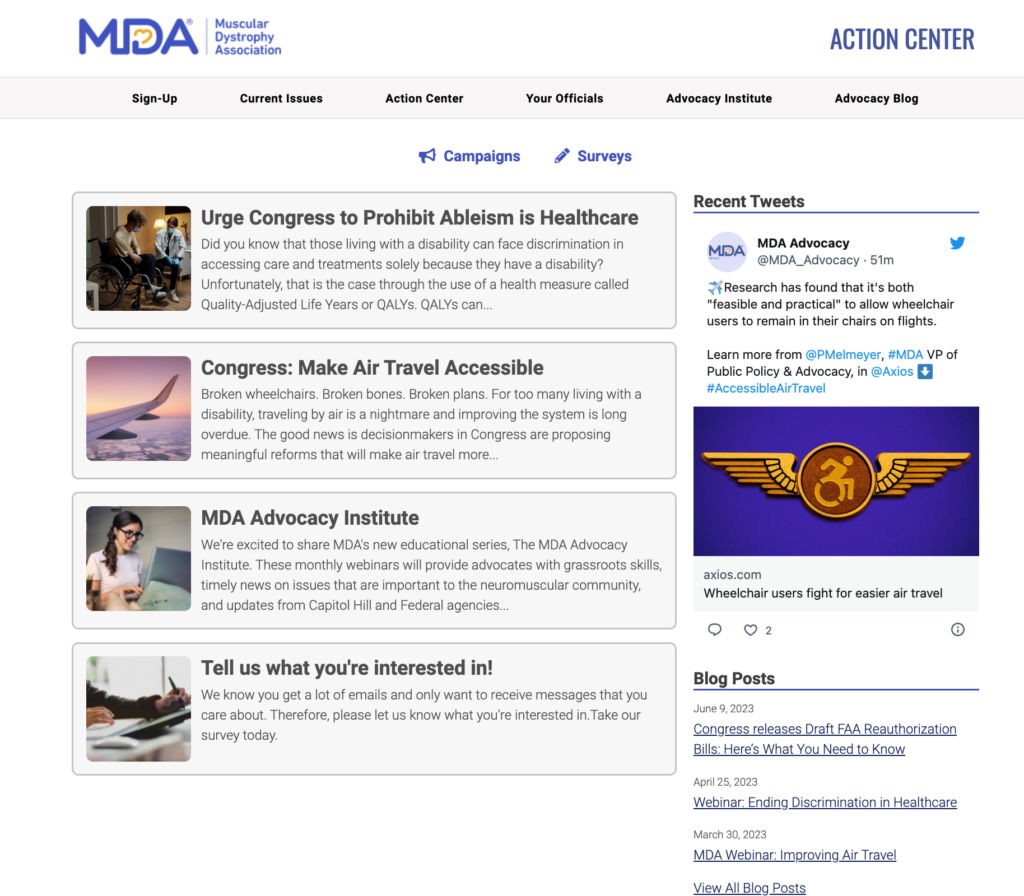 Empowering people living with muscular dystrophy, ALS, and other neuromuscular diseases is at the core of the Muscular Dystrophy Association (MDA). The organization supports research to find treatments and therapies and offers care centers, education, programs for children, and advocacy efforts that seek to change public policy to empower the people they serve.
Empowering people living with muscular dystrophy, ALS, and other neuromuscular diseases is at the core of the Muscular Dystrophy Association (MDA). The organization supports research to find treatments and therapies and offers care centers, education, programs for children, and advocacy efforts that seek to change public policy to empower the people they serve.
As the director of advocacy engagement at MDA, Mark Fisher focuses his grassroots efforts on three issue areas: access to care (making sure people have proper insurance, for example), accelerating therapeutic development (often working with the FDA and supporting clinical trials), and empowerment and independence (including preventing discrimination based on disability and accessible air travel).
Empowering Advocates in Working Toward Life-Changing Legislation
In 2023, Congress must reauthorize the Federal Aviation Act (FAA) to avoid major interruptions in air travel. This “must pass” bill is MDA’s best opportunity to enact measures that will improve air travel for people living with disabilities. MDA’s main goal is to not only improve the experience people now face while flying, but also lay the groundwork so that in the near future people will be able to drive their wheelchair onto the plane and lock it in place so they don’t have to stow it.
“People living with disabilities face a nightmare getting on airplanes,” Fisher says. Airplanes are the only mode of transportation not regulated by the Americans with Disabilities Act (ADA), and flying can be dangerous: people have been dropped and seriously injured when being lifted from their wheelchairs and into their seats on a plane.
Most wheelchairs must be stored under the plane, where they often get broken. “If they’re broken, it’s like someone breaking your legs — it is devastating,” Fisher says. “Power wheelchairs can take months to repair and can cost more than $50,000.”

MDA’s campaign lets advocates contact Congress in minutes, urging them to improve air travel for people living with disabilities.
This year MDA brought advocates from across the country to Capitol Hill for a fly-in on this issue. Some advocates arrived with wheelchairs that had been damaged during their flight. Another advocate was boarding the plane to attend the fly-in but had to turn around because some of the equipment he needs to travel with doesn’t fit on the plane. These incidents underlined the pressing need for reforms.
In all, 31 people attended the fly-in and had 31 key meetings with lawmakers. A draft of the FAA reauthorization was released three weeks later, which contains “much needed reforms,” Fisher says. Advocates also sent 7,400 messages to the Hill on the FAA reauthorization this year through VoterVoice, many with personal stories. “If the bill passes, it will be the most consequential bill improving air travel since the 1980s,” Fisher adds.
For all these efforts, “VoterVoice is our action center — the hub of the grassroots environment,” Fisher says. “It’s where we house our campaign to improve air travel and how people find us and take action.” His team also uses VoterVoice to house its webinars on air travel, let advocates find out who represents them, and see the impact their efforts are having. “VoterVoice is truly the heart of our grassroots action,” Fisher says.
Driving Change in the Department of Transportation
Last year, the Department of Transportation (DOT) was collecting comments on improving airplane bathrooms. The bathrooms on most planes are small, as most people who have flown can attest, and “imagine trying to use them if you have a disability,” Fisher explains. “Folks don’t do it — they dehydrate themselves to avoid using the bathroom on a plane.” This limits where people can travel and who they can visit, significantly impacting their quality of life.
The DOT collecting comments presented a huge opportunity for MDA advocates to improve this situation. Fisher was able to set up a VoterVoice campaign that automatically sent advocates’ messages straight to the DOT. He used behavioral data to contact people who had already taken action on other air travel issues and sent a separate email to those who hadn’t taken action yet but might be interested in the crucial topic.
The campaign resulted in more than 290 comments sent to the DOT to improve bathrooms for people with disabilities. More than 80 percent of the total comments the DOT received on this issue came from MDA advocates. These weren’t all form letters — over 40 percent of people customized their communication with their own personalized, impactful stories.
“I was really proud of those numbers,” Fisher says. “One of my favorite things about VoterVoice is how quickly you can set a campaign up for a time-sensitive issue, make it easy for people to take action, and easy to personalize.”
While the rule from the FDA has yet to be released, Fisher believes MDA supporters will have a big impact on their decision. As they await the decision, supporters receive a monthly newsletter and updates on pertinent legislation.
”VoterVoice is the best tool for our budget and our program. It’s the right tool at the right time for the right price, and everything it does, it does well.
Mark FisherDirector of advocacy engagement, Muscular Dystrophy Association
The Best Tool for the Job
MDA has an advocacy team of five, and their biggest challenge by far is having too much to do, Fisher says. “There’s so much to do to empower the lives of the people we serve — we don’t have the capacity to do it all,” he says.
Meeting this challenge requires prioritization and the right tools. Enter VoterVoice, the force behind MDA’s important advocacy campaigns. “VoterVoice is the best tool for our budget and our program,” Fisher says. “It’s the right tool at the right time for the right price, and everything it does, it does well.”
For a busy team with many issues to tackle, another benefit of using VoterVoice is its ease of use. “VoterVoice is the most intuitive system out there,” Fisher says. “It’s the easiest one I’ve ever used to set up campaigns and messages from start to finish.” So simple that, when Fisher was out of the office recently and urgent action was needed, his supervisor — who had never used VoterVoice before — was able to quickly edit a campaign, set up an email, and send it out, thanks to the straightforward nature of the platform.
Targeting Communications to Drive Results
MDA relies on VoterVoice to empower advocates to take action and contact their members of Congress. But before sending a campaign to supporters, Fisher trusts VoterVoice data to decide which advocates to target.
“Not every person in our network wants to take action on every single issue,” he says. He refers to advocates’ self-reported data (surveys powered by VoterVoice that link back to an advocate’s profile and indicate which issues they’re interested in) and behavioral data (previous actions people have taken, whether attending an MDA webinar or signing a petition). He uses this information to figure out who is most likely to take action on any given campaign.
”We hear all the time from advocates, members of staff, and our board members that VoterVoice is so easy to use. That’s the biggest thing you want: for people to be able to take action easily.
Mark FisherDirector of advocacy engagement, Muscular Dystrophy Association
Simplifying Advocacy for Supporters
Relying on VoterVoice makes advocacy campaigns streamlined not only for Fisher but also for the MDA’s advocates. “We hear all the time from advocates, members of staff, and our board members that VoterVoice is so easy to use,” he says. “That’s the biggest thing you want: for people to be able to take action easily.” MDA supporters appreciate that they can make their voice heard by the right people so quickly.

MDA’s action center, powered by VoterVoice, is where the organization houses its campaigns and mobilizes supporters to take action.
Reporting Capabilities that Show Success
After his email campaigns are sent out, Fisher monitors results against VoterVoice’s benchmarks to see how his messages are performing. VoterVoice reports show how campaigns stack up against others in the industry. “Having industry data right next to our own performance is very valuable and helpful,” Fisher says. “It shows me if we were successful, especially when it comes to action rates.”
Another report Fisher uses is VoterVoice’s mapping capability. After a recent phone call alert, he could easily see on a map what states calls came from and at what volume. “The reporting is easy to understand and provides me the necessary information I need to report on how successful we were,” he says.
Ready to see for yourself?
See how our 360-degree approach to managing advocacy and policy issues can help you promote action, manage risk, as well as assess your impact and drive results.


